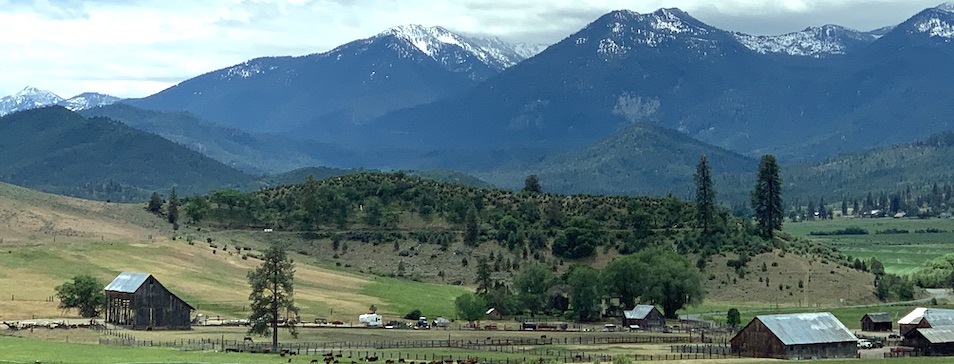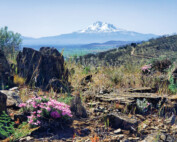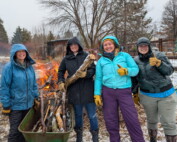
What is a land trust?
Land trusts, such as Siskiyou Land Trust, are nonprofit organizations that actively work with willing landowners and agencies to conserve land. This is accomplished either by creating conservation easements on private land or by ownership of lands fee and clear. Conservation easements protect land in perpetuity and must be monitored annually by SLT to enforce the terms of the easements. There are also responsibilities of stewardship on the lands that are owned by SLT. Siskiyou Land Trust is an independent community nonprofit in Siskiyou County, founded in 1992, run by a staff of employees and volunteers, and governed by a Board of Directors.
What is a conservation easement?
A conservation easement (called a “CE”) is a legal agreement that a landowner voluntarily creates with the help of a land trust or other organization. This document permanently limits uses of the land in order to protect its significant natural features and guarantee that each portion of the land is used in its optimum way, i.e for agriculture, wildlife or human development. The landowner continues to own and use the land, and to sell it or pass it on to heirs. The conservation easement will “run with the land,” requiring future owners of the land to abide by the terms of the conservation easement. The easement is owned by a governing agency, like SLT. While it is created by the land owner, it cannot be owned by the land owner, as that would be a conflict of interest.
What are the benefits to a landowner to put a conservation easement on their property?
The landowner knows that their land will be protected under the specific terms of their conservation easement in perpetuity. A conservation easement donation can result in significant tax benefits if it meets the requirements of federal law. It may lower federal income tax. It may also lower their state income tax or property tax. A conservation easement may be a benefit to estate planning and help pass land to the next generations by lowering estate taxes. The families and organizations who have worked with SLT tell us that their greatest reward is the satisfaction and peace of mind that comes from knowing their land will remain forever a part of our region’s unique landscape, without subdivision and inappropriate development.
What sort of limitations are included in a conservation easement? Do I give away my land? Can the land be farmed, logged, lived on or does it revert to a wild state? Is there public access?
Conservation easements must provide public benefits, but there are many different options available. If it is private land, a CE rarely means there will be public access. Public benefits most often come from the protection of headwaters areas and sustainable forests. The landowner helps set up their conservation easement, and will specify what sort of future development is appropriate, what types of agricultural use can take place, what sort of logging can be done, and so on.
SLT tends to focus on projects that include the permanent protection of open space, farm and ranch land preservation, healthy forests, rivers, streams and wetlands, natural resources, scenic views and wildlife corridors and habitat.
What does the Land Trust do to create a conservation easement with a landowner?
There are many steps involved in making this complex legal document…from working with the landowner to establish their vision for the future of the land, to researching the many implications of the project, locating partnerships with agencies and funding sources, arranging appraisals, surveys and other supporting documents. Each project is unique. Just one of the many tasks is setting up the Baseline Conditions Report that maps and documents the condition of the land. In this video, Renee Casterline tells of SLT’s work on the large tracts of forest in the Scott River Headwaters projects during 2020, and how the information is used in the future to protect and preserve the landscape.
What are the costs of creating a conservation easement? How are these costs covered?
The cost of creating a conservation easement is largely based on the appraised value. Most of that money is provided through grants from both federal and state agencies. There is also a stewardship fund that goes with a donated conservation easement to cover the cost of annual monitoring and other stewardship needs, commonly in the neighborhood of 6% of the CE value
What responsibilities does a Land Trust have after we help a landowner create a conservation easement?
Creating a conservation easement is just the first step. Each conservation easement needs to have an organization designated to take responsibility for monitoring the land in perpetuity. Often SLT agrees to hold the conservation easement after the legal filing of the document. In those cases, SLT takes on significant stewardship responsibilities, year after year, to closely observe the use of the land, make sure that the agreements in the CE are being followed, and working with the landowner to mitigate any discrepancies. It is a “forever” commitment, and becomes a major part of the future work of the Land Trust.
When is it appropriate for SLT to own land and how are these properties handled?
Sometimes land is donated to SLT by an owner wishing to have that land preserved and managed in perpetuity. Other times, SLT becomes the owner of land that the community wants to purchase and put into permanent protection. For example, the Kingston Road property is held by SLT for the benefit of community trail. Both types of lands are critically important to SLT’s mission, and add a significant stewardship responsibilities. When SLT owns a piece of land with a CE on it, the CE must be owned by another entity with arms length.
What is the next step if I have an interest in putting a conservation easement on my land?
Start by talking with SLT to see if we are a good fit for your project. We will discuss the conservation values you want to protect and how you want to use the land. Be sure to talk with family members as you consider your conservation options. This is a big decision, so it’s important to consult with your attorney and financial advisors, too.
How can I support the work of SLT?
A donation made to SLT, in whatever amount fits your budget, is a tremendous help. When you give a tax-deductible donation to SLT, you’re protecting lands and waters where people and wildlife thrive. You are helping to preserve breathtaking beauty, climate-resilient forests, thriving agriculture, and rural community values. You can make a one time gift, or schedule monthly or annual donations…it’s all tax-deductible. You can add SLT to your will or estate plans, donate an old car, or make a gift of stocks. You can volunteer to work on stewardship projects or SLT community events.
There’s so much you can do to support this good work. We can’t do it without you.




